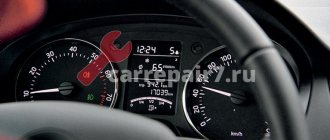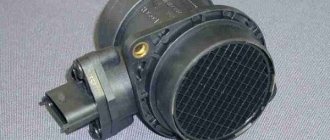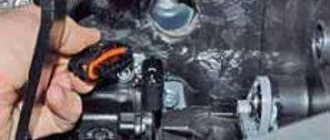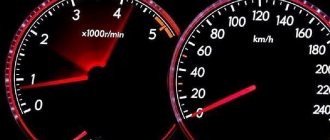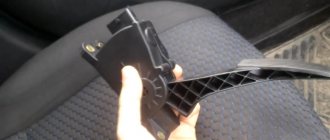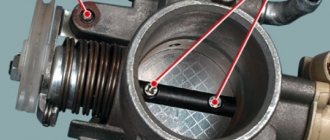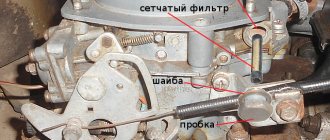Lada Granta does not respond to pressing the gas pedal, what should I do?
In connection with the introduction of European exhaust emission standards, at the beginning of 2011, the AvtoVAZ concern began equipping Lada cars with the E-gas system. Subsequently, the manufacturer provided Grant with an electronic gas pedal.
The general meaning of the operation of the electronic system is that by moving the gas selector pedal, special sensors are activated, which are located in the gas pedal module (hereinafter referred to as MPG). With each change in the force exerted on the MG, the resistance of the sensors also changes. After which an electrical signal is generated, which enters the ECU, is read, processed, and depending on the degree of pressing and the results of processing, the final operation of the throttle valve is regulated.
Electronic gas pedal repair – we fix the breakdowns ourselves
Basically, if any problems occur, the entire assembly must be replaced. But before taking such drastic actions, it would not hurt to find out the cause of the breakdown. To do this, of course, it is worth reading the information on how to check the electronic gas pedal. To do this, you need to disconnect the block and sensors, and then unscrew the fastening nuts and remove the pedal.
To directly check, you will need a multimeter: by connecting it to different terminals, we monitor the change in electrical resistance. It should decrease smoothly, but if jumps are observed, then the part is faulty.
In some cases, it is also possible to repair the electronic gas pedal, for example, if the wiring is damaged. So, having discovered a defect (the insulation is broken, the wires themselves are damaged, etc.), you need to act according to the following scheme. Having freed the gear mounting axis, remove the harness. To do this, you need to unsolder the wires, release the bracket and pull out the cable. Then we replace the wires, and, having disassembled the connector under the pedal, solder them. Now you can assemble the damper and drive safely.
If the car reacts to pressing the accelerator, so to speak, “with a delay,” then a spur (electronic corrector) of the gas pedal is needed. This device allows you to reduce the interval between pressing and opening the damper to a minimum. This is a separate module that connects to the sensors and, through a microprocessor, converts the signals supplied from them, and then supplies them to the controller.
So we see that the electronic gas pedal, tuning of which is possible in any specialized center, on the one hand, is a clear result of progress, and on the other hand, it somewhat limits our desires. True, if you do not belong to the category of those people who need to “drive with the breeze”, but prefer to drive carefully with minimal fuel consumption, then this option will be just for you.
Adjusting old-style E-gas
The block cover (11183-1108500) is fixed with bolts that are inserted into oval holes. The improvement is this. to loosen the 4 screws and turn the cover in the desired direction:
- Economy mode (counterclockwise). To drive smoothly, to accelerate, you should press the pedal a little more than before. Gasoline consumption is reduced;
- Active mode (clockwise). The car reacts even with slight pressure on the gas pedal. Gasoline consumption increases. The pedal becomes more sensitive and informative.
In other words, we get the same effect as after installing JETTER (Jetter or spur).
It has been noticed that the first minutes after such settings, the idle speed may be increased (about 1300 rpm). But after a minute, the ECU gradually adjusted and the speed dropped to the usual level. If this does not happen, turn on the ignition for a minute and then start the engine.
If necessary, you can easily return to the original position (mark it in advance).
Power failures in carburetor VAZ and foreign cars
In this case, failure means an unexpected malfunction of the engine, which follows immediately after the driver presses the accelerator pedal. Such interruptions are especially typical for domestically produced carburetor cars: VAZ 2114, VAZ 2106, VAZ 2101 and others.
Two seconds when starting to move (pressing the gas pedal)
After a sharp press on the gas, one or several dips lasting 2-3 seconds occur; as the speed increases, the problem disappears. A similar picture can be observed in idle mode. As a rule, this happens because the inlet holes in the first carburetor chamber are clogged. Dips may also appear due to a breakdown of the accelerator pump on the carburetor. In the first case, you should remove the carburetor, clean (or better yet, rinse with kerosene) the transition channels of the first chamber. And in the second case, only replacing the accelerator pump will help.
Description of the problem
In general, there was a terrible downpour, puddles on the roads, and general floods in the yards.
Heavy rain could affect the operation of the car's electronic systems
But we had to go, my wife and daughter were in the shopping center, and the queue for the minibus, according to them, was huge. I am inclined to believe that the minibuses simply stalled (we have old, decrepit Gazelles in our city).
We have one place that is constantly flooded. I look, and there are new Kia Sid floating on the radiator grille in the water, well, I’m taller, I thought that nothing would happen. Here, as luck would have it, the traffic light is still red, and the intersection is straight, only a pedestrian crossing, on which there is no one at all, since it is knee-deep in water. Most people pass it, even on red lights, quietly. And I’ve only been driving for a month, I’m not used to breaking rules yet. Has stopped.
Belt whistled due to water ingress
My Granta is standing there, waiting for the green light, and then the alternator belt started whistling, as if it was slipping. I see the voltage on the on-board computer jumps, from 13 Volts to 11.8, and there is a whistle under the hood. The light turned green and I was off. I started, drove out of the puddle, accelerated a little and the whistle disappeared. The voltage on the on-board computer screen leveled out to 13.6.
Among the current consumers, my headlights were on, the rear window was heated, the tape recorder was working quietly, and the heater was turned on at second speed to blow the windshield.
I got to the shopping center, stopped, and waited for my wife and daughter. The engine begins to vibrate and bleed a little. I went home already on the detour, there are fewer puddles there. I dropped everyone off and decided to go to the garage.
I started the engine, the revolutions jumped to 6000, I was already scared. Then they dropped to 1000, the engine sneezed and died. The check engine light on the dashboard came on. It started again, it idles, but pressing the gas pedal does not respond. I try to start, it idles and doesn’t respond to the pedal at all when driving. So I drove to the garage in second gear, well the 21116 engine is torquey and drives like a tractor.
I repeated the experiment in the garage. I started it up, tried to press the gas pedal, nothing happened, the revs were like a glove, the engine icon was still on.
How I solved the problem of gas pedal failure
- I took a smoke break and decided to remove the terminal from the battery.
- I reset it and waited five minutes. He swore that he forgot the diagnostic adapter at home.
- Reconnected the terminal and started it.
- “Jackie Chan” stopped burning, the engine reacts to the gas pedal with a vigorous increase in speed. The engine really didn’t start at first, it started only the second time.
I left the garage, circled along the pit line, and came back. There were no signs of damage. Now I'm afraid to drive in the rain.
What could it be? Now I’m subconsciously afraid that if I start the engine, my Lada Granta won’t want to go anywhere in rainy weather. How likely is this situation to happen again?
Possible reasons
Why is this happening? There may be many reasons why the Lada Granta does not start, but in this case the problem is in the electrical contacts and connectors, namely in a bad ground on the starter. And this is just one of the symptoms.
After a long stay, you need to check the battery charge level, because with a dead battery, not only the Grant, but any other car will not start. In addition, check whether the terminals on the battery fit well and in what condition they are. If the car is already 3 years old, this is already time for the wires to oxidize, so special attention should be paid to electrics.
Replacing the gas pedal on Grant
The replacement procedure is quite simple and does not require special technical means. In order to dismantle the unit you will need: - A key for 10.
Sequential steps to replace the gas pedal of a Lada Granta:
1. The first step is to remove the negative terminal from the battery. 2. Next, you need to move to the driver’s side of the car. 3. Above the gas pedal, find and disconnect the contact chip that is connected to the sensor connector.
4. After that, take a 10mm wrench and unscrew the three fastening nuts. When there is insufficient internal space, it is most convenient to use a socket wrench.
5. Remove the pedal from the special mounting pins. Reinstallation is carried out in a mirror sequence.
Adjusting the sensitivity of the gas pedal
"Note! Not only the pedal and its module take part in controlling the operation of the throttle valve; the throttle control unit plays an important role. Therefore, this product should also be given special attention in cases where the MPG is in a known good condition, but problems with engine speed remain.”
Diagnostics
Most often, drivers complain about the following problems with electronic gas:
- The speed fluctuates (standby mode);
- The engine does not respond to gas (emergency operation);
- Pedal play.
If in the latter case the malfunction may be purely mechanical, then in the first two there is clearly a problem with the electronics. In this case, the initial diagnosis of the electronic gas pedal can be carried out independently, but for this it must first be dismantled:
- Disconnect the block with wires;
- Using a “10” wrench, unscrew the three nuts securing the pedal;
- Remove the pedal.
To check the condition of the moving contacts and conductive paths of the gas pedal position sensors:
- Using a multimeter in ohmmeter mode, check the resistance between contacts “4” and “2”. Slowly move the gas pedal, at this time the resistance should change smoothly.
- We also check the resistance between contacts “4” and “3”.
- To check the conductive paths of another sensor, we measure the resistance between two other pairs of contacts: “1” and “6”, as well as “6” and “5”.
If there is an abrupt change in resistance on any of the pair of contacts described above, we can say with confidence that the E-gas pedal is faulty. It will need to be replaced as a whole with a new one.
Please note that when installing the pedal in place, the nuts must be tightened with a torque of 6-8 Nm.
Malfunctions
In general, the electronic assembly is more reliable than the cable. There are fewer rubbing parts; the electronics constantly monitor not only the position of the gas pedal, but also the throttle valve. In the event of a malfunction, the electronics simply will not allow the driver to start moving.
At the same time, the pedal assembly has contacts and conductive tracks that are subject to wear. If it is higher than normal, then the engine will operate unstably; at idle, the engine speed will “float” and “fail.” The electronics will signal a malfunction using the “Check Engine” warning lamp. In this case, the ECU will go into standby mode, in which the engine speed will change very slowly, even if you press the gas pedal sharply. This mode of operation and the “Check Engine” signal are an indication that there is a fault in the contacts.
But if two sensors in the pedal assembly or the throttle control module malfunction at the same time, it leads to emergency operation. In this case, the electronics will keep the engine operating at 1500 rpm. To fix the problem, you will need to contact a service station.
Conditions for carrying out the idle speed adaptation process
Before starting training, a number of prerequisites must be met:
- travel by car for 10 minutes;
- ensure that the battery voltage at idle is at least 12.9 V;
- warm up the gearbox;
- The wheels of the vehicle must be straight, the steering wheel must be in the middle position;
- engine temperature – 70–95 °C;
- all devices that put a load on the car’s electrical network (heated windows, headlights, etc.) should be turned off;
- The automatic transmission selector is set to N or P.
In order for the factory wiring of the Lada Grant to serve for a long time and not break, experienced experts strongly recommend following a number of simple rules.
- Periodically check all contact connectors and terminals for oxidation and rust. Such damage to the connections can cause a short circuit and a critical decrease in the conductivity of the line, which is perceived by the on-board computer as an error or breakdown.
- Use only original consumables and electronic components. The use of counterfeit products does not guarantee the functionality of the circuit. At the same time, some elements, when damaged, cause a voltage drop in the network, which becomes a direct cause of failure of other equipment or a fire.
- Use special oil to treat contact groups. The fluid is sold in auto shops or electronics stores. After treatment, the contacts are covered with a moisture-impermeable layer, which increases their service life by 2-3 times.
- Carefully monitor the charge level and condition of the battery. The wiring of the Lada Granta critically perceives a significant voltage drop in the on-board circuits. As a result, this may cause damage to the firmware of electronic control units.
Lighting up correctly
“Lighting a cigarette” is another way to start a car.
A method proven by driving experience to start the engine in difficult situations is to light it, that is, to power the starter from the battery of another car.
First of all, we must take into account that the wires for lighting should have as large a cross-section as possible. The cars are positioned with their hoods facing each other, but not touching. The positive terminals of both car batteries are connected by one wire. The other wire is connected to the minus of someone else's battery, and the other end is shorted to ground.
Do not connect wires to the negative of a dead battery. In this way, you can only charge the battery, but not start the engine, although in some cases this is enough.
If the engine does not start, connect the crocodile to the negative terminal of the dead battery directly from the negative terminal of the working battery of another car. Be careful, touching the positive contact will cause a short circuit.
Once started, do not rush to remove the wires; let the engine run for a while. Remember, the negative wire is removed first; the headlights cannot be turned on at the same time, so that they do not burn out during a power surge.
Whatever happens, don't panic. The Lada engine does not start - look for related faults. Some of them are indicated in the Lada Granta operating manual. If you have any difficulties, do not hesitate and go to the service station, especially if the car is still under warranty. Know that there are problems that only a professional can fix. Don't try to deal with them on your own. Good luck!
Reasons for the appearance of symptoms of error P2135 on the Lada Granta
On different cars, with different numbers of sensors and different control units, the reasons may be slightly different. Although in almost any case, an intelligent diagnostician will first of all consider this number of reasons:
- Wear of resistor tracks in the electronic damper drive housing.
- Lack of contact in the damper drive board.
- Circuit shorted to ground.
- Failure of throttle position sensors.
- Engine control module software failure.
- Mechanical damage to the ECU, moisture ingress into the unit housing.
- Poor contact on the throttle assembly, gas pedal position sensor or on the ECU itself.
Electronically controlled throttle valve circuit
In relation to the Lada Granta, we can safely consider problems with angle sensors or damage to the computer, oxidation of contacts, as well as failures in the module firmware. However, if error P2135 on a Lada Granta appears in the company of codes P012%, P022%, P1538, where % is any number, you can safely blame the throttle assembly.
Advantages and disadvantages of electronic gas for Grants
The system is designed in such a way that there is no need for mechanical parts connecting the accelerator itself and the throttle assembly. This approach provides a number of advantages, such as:
- reduced fuel consumption and reduced exhaust toxicity;
- instant response from the control unit to manipulations with the accelerator;
- soft pedal stroke;
- smooth distribution of engine speed.
There are also some disadvantages that car enthusiasts face. These include:
- a smooth increase in engine speed when you sharply press the gas pedal;
- low maintainability of the unit in case of failure of its components (replacement of the assembled unit);
- some inconveniences when modifying the engine.
Throttle assembly Lada Granta
Features of the Lada Granta throttle assembly
The throttle valve is turned by an electric motor through a gearbox. Both are built into the throttle body. When starting and warming up the engine, as well as during idling, the flow of air into the cylinders is regulated by opening the throttle valve. The throttle position is controlled by two sensors built into the throttle body.
